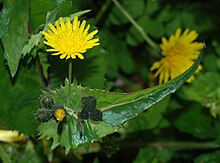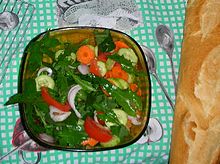Sonchus oleraceus
| Common sowthistle | |
|---|---|

| |
| Scientific classification | |
| Kingdom: | Plantae |
| Clade: | Tracheophytes |
| Clade: | Angiosperms |
| Clade: | Eudicots |
| Clade: | Asterids |
| Order: | Asterales |
| Family: | Asteraceae |
| Genus: | Sonchus |
| Species: | S. oleraceus |
| Binomial name | |
| Sonchus oleraceus L. 1753 not Wall. 1831 | |
| Synonyms[1] | |
Synonymy
| |
Sonchus oleraceus is a species of flowering plant in the tribe Cichorieae of the family Asteraceae, native to Europe and Western Asia. It has many common names including common sowthistle,[2] sow thistle,[3] smooth sow thistle, annual sow thistle,puha,[4] hare's colwort, hare's thistle, milky tassel, milk thistle,[5] and soft thistle.[5]
Its specific epithet oleraceus means "vegetable/herbal".[6][7][a] The common name 'sow thistle' refers to its attractiveness to pigs, and the similarity of the leaf to younger thistle plants. The common name 'hare's thistle' refers to its purported beneficial effects on hare and rabbits.[8]
Botanical characteristics
This annual plant has a hollow, upright stem up to 30 to 100 centimetres (12 to 39 in) high.[9] It prefers full sun, and can tolerate most soil conditions. The flowers are hermaphroditic, and common pollinators include bees and flies.[10] It spreads by seeds being carried by wind or water.
Invasiveness
Annual sowthistle is considered an invasive species due to its rapid growth, prolific seed production, and wide dispersal. The plant thrives in disturbed environments, such as roadsides and agricultural fields, spreading aggressively through wind-dispersed seeds. It forms dense populations that outcompete native vegetation by quickly establishing in open areas, particularly after soil disturbance. Sowthistle's resilience to various soil types and its ability to reseed itself make it difficult to control in many regions.[11][12][13]
In Australia it is a common and widespread invasive species, with large infestations a serious problem in crops.[14]


Cuisine

Leaves are eaten as salad greens or cooked like spinach. This is one of the species used in Chinese cuisine as kŭcài (苦菜; lit. bitter vegetable).[citation needed] The younger leaves are less bitter and better to eat raw. Steaming can remove the bitterness of older leaves.[15] The younger roots are also edible and can suffice as a coffee substitute.[16]
Nutritive qualities
Nutritional analysis reveals 30 – 40 mg of vitamin C per 100g of plant, 1.2% protein, 0.3% fat, 2.4% carbohydrate. Leaf dry matter analysis per 100 g (likely to vary with growing conditions) shows: 45 g carbohydrate, 28 g protein, 22 g ash, 5.9 g fibre, 4.5 g fat; in all, providing 265 calories.
Minerals
- Calcium: 1500 mg
- Phosphorus: 500 mg
- Iron: 45.6 mg
- Magnesium: 0 mg
- Sodium: 0 mg
- Potassium: 0 mg
- Zinc: 0 mg
Herbalism
Sonchus oleraceus has a variety of uses in herbalism. It also has been ascribed medicinal qualities similar to dandelion and succory.[8] The early Māori people of New Zealand are likely to have gathered it for food and medical use,[17] where it is known as puha[18]
Native Americans had many uses for this plant. Pima used its gum as a "cure for the opium habit," as a cathartic, and as a food, where the "{l}eaves and stems {were} rubbed between the palms of the hands and eaten raw" and sometimes "boiled." The Yaqui used the plant as a vegetable, where the "{t}ender, young leaves boiled in salted water with chile and eaten as greens." The Kamia (Kumeyaay) "boiled {the} leaves {and} used {it} for food as greens." The {Houma} used it as an abortifacient where an "{i}nfusion of {the} plant {was} taken to 'make tardy menstruation come;'" an antidiarrheal; for children that were teething; and as hog feed.[19]
The Samaritans eat the leafs of this bitter plant on the feast of passover. The bitter leafs are eaten together with Paschal lamb and unleavened bread, as dictated by the Bible (Exodus 12, 8): “ They shall eat the flesh that night, roasted on the fire; with unleavened bread and bitter herbs they shall eat it.” Thus, the Samaritans identify Sonchus oleraceus with the bitter herbs.
References
Footnotes
- ^ For the generic name's etymology, see Sonchus.
Citations
- ^ The Plant List, Sonchus oleraceus (L.) L.
- ^ NRCS. "Sonchus oleraceus". PLANTS Database. United States Department of Agriculture (USDA). Retrieved 19 November 2015.
- ^ Sonchus oleraceus at Plants For A Future
- ^ https://herbs.org.nz/site/assets/files/1214/puha.pdf
- ^ a b International Environmental Weed Foundation, retrieved 24 December 2015
- ^ Parker, Peter (2018). A Little Book of Latin for Gardeners. Little Brown Book Group. p. 328. ISBN 978-1-4087-0615-2.
oleraceus, holeraceus = relating to vegetables or kitchen garden
- ^ Whitney, William Dwight (1899). The Century Dictionary and Cyclopedia. Century Co. p. 2856.
L. holeraceus, prop. oleraceus, herb-like, holus, prop. olus (oler-), herbs, vegetables
- ^ a b "A Modern Herbal | Sow-Thistles". Botanical.com. Retrieved 2014-07-12.
- ^ Tanaka, Yoshitaka; Van Ke, Nguyen (2007). Edible Wild Plants of Vietnam: The Bountiful Garden. Thailand: Orchid Press. p. 52. ISBN 978-9745240896.
- ^ "Sonchus oleraceus Sow Thistle, Common sowthistle PFAF Plant Database".
- ^ "Sonchus (Common Sowthistle, Hare's Thistle, Milky Tassel, Sowthistle, Sow Thistle) | North Carolina Extension Gardener Plant Toolbox". plants.ces.ncsu.edu. Retrieved 2024-09-11.
- ^ Sonchus oleraceus Archived 2007-04-28 at the Wayback Machine at Center for Aquatic and Invasive Plants Archived 2007-03-25 at the Wayback Machine
- ^ Sonchus oleraceus L., Asteraceae, Pacific Island Ecosystems at Risk (PIER)
- ^ "Common sowthistle Sonchus oleraceus". Weeds Australia. Retrieved 25 September 2014.
- ^ Nyerges, Christopher (2016). Foraging Wild Edible Plants of North America: More than 150 Delicious Recipes Using Nature's Edibles. Rowman & Littlefield. p. 169. ISBN 978-1-4930-1499-6.
- ^ Nyerges, Christopher (2017). Foraging Washington: Finding, Identifying, and Preparing Edible Wild Foods. Guilford, CT: Falcon Guides. ISBN 978-1-4930-2534-3. OCLC 965922681.
- ^ Cambie, Richard C; Ferguson, Lynnette R (2003). "Potential functional foods in the traditional Maori diet". Mutation Research/Fundamental and Molecular Mechanisms of Mutagenesis. 523–524: 109–117. doi:10.1016/S0027-5107(02)00344-5. ISSN 0027-5107. PMID 12628508.
- ^ https://herbs.org.nz/herbs/puha/
- ^ "BRIT - Native American Ethnobotany Database".
External links
 Media related to Sonchus oleraceus at Wikimedia Commons
Media related to Sonchus oleraceus at Wikimedia Commons- Tropicos.org: photo of herbarium specimen at Missouri Botanical Garden
- Tropicos.org: line drawing from Flora of Panama
- Nature Manitoba: Annual Sow-thistle (Sonchus oleraceus) — photos, drawings, & text from Wild Plants of Winnipeg.
